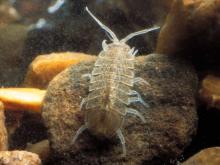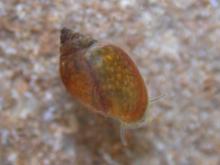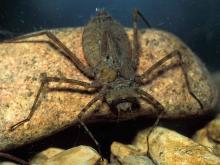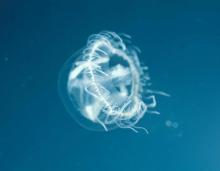Aquatic Invertebrates
Media

Species Types
Scientific Name
Freshwater members of the crustacean order Isopoda
Description
Everyone knows about terrestrial sowbugs and pillbugs, but many isopod species are aquatic. Missouri has several isopods that live in streams, ponds, rivers, and caves.
Media

Species Types
Scientific Name
Bivalve molluscs in order Unionoida
Description
Secretive and seldom seen, freshwater mussels are extraordinarily diverse in Missouri. We have nearly 70 species within our borders. Many are declining, and several are endangered.
Media

Species Types
Scientific Name
Over 20 Missouri species in former subclass Prosobranchia
Description
Gilled snails are one of two main groups of aquatic snails in Missouri (the other group is the "lunged" snails). Gilled snails, or prosobranchs, breathe with gills and possess a hard trapdoor-like operculum. They are most common in the Ozarks.
Media

Species Types
Scientific Name
Over 30 Missouri species in former subclass Pulmonata
Description
Pulmonate, or lunged snails breathe via a lunglike pulmonary cavity, and they lack the hard trapdoor-like operculum found in gilled snails. Except for in the Ozarks, pulmonate snails predominate in most of the aquatic regions in our state.
Media

Species Types
Scientific Name
Gyraulus, Helisoma, Menetus, Micromenetus, Planorbula spp.
Description
Ramshorn snails are easy to identify at a glance, because the shell is a flat, disklike coil. Like other pulmonate aquatic snails, they lack the hard horny “trapdoor” possessed by other types of aquatic snails.
Media

Species Types
Scientific Name
Species in the suborder Anisoptera
Description
Dragonfly larvae are aquatic insects with large eyes, six legs, and an oval or rounded segmented abdomen. The lower jaws are scooplike and cover much of the lower part of the head.
Species Types
Scientific Name
Various species in the genus Hydra
Description
We’ve all seen aquariums and pictures of tropical saltwater invertebrates such as corals, jellyfish and anemones—but did you know that there are similar creatures living in the freshwater habitats of Missouri?
Media

Species Types
Scientific Name
Craspedacusta sowerbii (syn. C. sowerbyi)
Description
You may have heard about stinging jellyfish in the ocean, but did you know that there are similar creatures living in the freshwater of Missouri? Fortunately, they’re harmless!
Media

Species Types
Scientific Name
Freshwater species in the phylum Bryozoa
Description
Bryozoans are tiny, filter-feeding invertebrates. They create colonies that can be mossy, branching, or round and jellylike.
Media

Species Types
Scientific Name
Species in the beetle family Gyrinidae
Description
Groups of whirligig beetles swim on the water surface in quick, random patterns, searching for food. They have two pairs of eyes — one pair above water, one pair below — to help them quickly and accurately capture their prey.
See Also
About Aquatic Invertebrates in Missouri
Missouri's streams, lakes, and other aquatic habitats hold thousands of kinds of invertebrates — worms, freshwater mussels, snails, crayfish, insects, and other animals without backbones. These creatures are vital links in the aquatic food chain, and their presence and numbers tell us a lot about water quality.





















